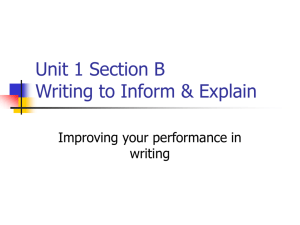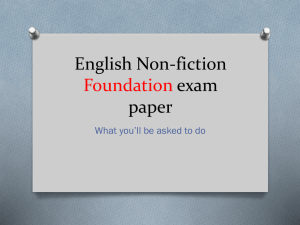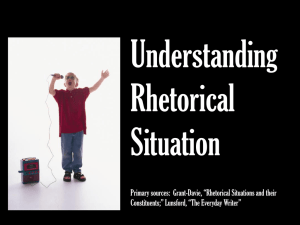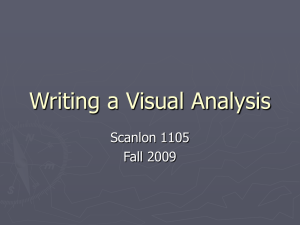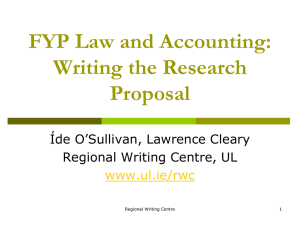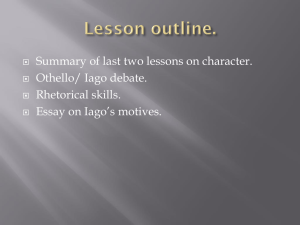Writing to Persuade - Royton and Crompton School
advertisement
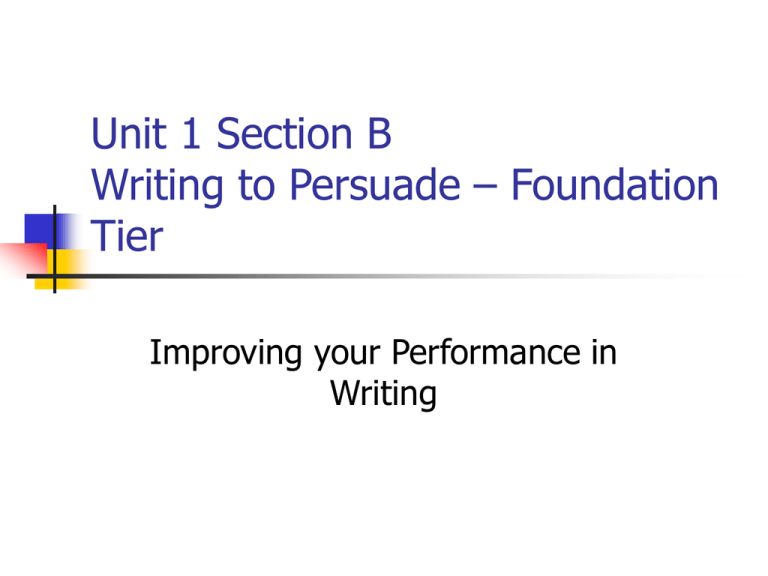
Unit 1 Section B Writing to Persuade – Foundation Tier Improving your Performance in Writing The Exam – Section B You should spend about an hour on Section B 2 Writing tasks Shorter task: Writing to Inform / Explain (25 minutes) Longer task: Writing to Persuade (35 minutes) 40 marks available What is Writing to Persuade? Promotes a point of view Gives lots of reasons why somebody should do what you want them to do Use lots of rhetorical devices to achieve an impact on the reader Examples of tasks Write the text for a speech persuading your local council to spend more money on facilities for young people Write a letter to a TV company persuading them that they should produce more interesting programmes for young people Write an article for a local newspaper persuading readers to visit a local attraction Assessment Objectives AO4(i) – Communication AO4(ii) – Organsiation Ideas, addressing the audience, meeting the purpose Type of text, overall structure, use of paragraphs and sentences AO4(iii) – Technical Accuracy Accuracy of writing skills and vocabulary Mark Band 3 Criteria AO3(i) Communication AO3(ii) Organisation Clear ideas Successful communication Detailed persuasive ideas Appropriate level of formality for the reader Uses rhetorical devices Uses discourse markers Uses paragraphs that are linked together Range of structural features e.g. different paragraph lengths AO3(iii) Technical Accuracy Range of punctuation used accurately Sentences correctly separated Variety of sentences for effect Correct spelling of ambitious words Uses standard English What do I need to do? Structure your writing carefully, showing different viewpoints Make your writing interesting to read Use a range of rhetorical devices for effect Use a wide range of paragraphs and types of sentence for effect Use a wide range of punctuation for effect Spell sophisticated words correctly and use an ambitious vocabulary Writer’s Toolkit Overall Structure Remember to create a detailed plan Write an imaginative opening to engage your reader i.e. a rhetorical question Link your conclusion back to your opening Vary the length of your paragraphs e.g. a one-sentence paragraph Use a range of connectives to link your paragraphs together Writer’s Toolkit Rhetorical Devices Rhetorical questions x2 Lists of three x 2 Emotive language Anecdotes Facts and Statistics Audience involvement Direct address Personal involvement Alliteration Repetition Over-exaggeration Expert opinions Writer’s Toolkit Sentence Structure Questions Exclamations Short sentences for impact Complex lists e.g. There are many reasons not to smoke: it is bad for your health; it makes you smell; it is very expensive. Begin with a reason Begin with a verb Move your subordinate clauses around e.g. at the beginning Writer’s Toolkit Range of Punctuation Exclamation / question marks Brackets to show sarcasm Inverted commas for irony Apostrophes for omission and possession Use a colon instead of ‘because’ or ‘so’ Use a semi-colon to show that 2 statements are closely linked Put a comma after a connective at the beginning of a sentence Why use a Text Skeleton? It helps you to visualise what your writing should look like… It helps you to structure the writing effectively… It shows the examiner you know what you are doing… Plan your opening – 3 main reasons Develop your reasons using PEE Chains Plan a conclusion – link all your reasons together and make a final BIG statement Don’t forget to add lots of rhetorical devices Link each paragraph with connectives Approaching the task 1. 2. 3. 4. 5. 6. Analyse the task: work out the PAFT Think of an interesting opening Plan your ideas: 3 clear reasons Think of an effective conclusion – link back to your opening and your main points + one BIG reason Add connectives Add rhetorical devices PURPOSE: what job is the writer trying to do? Argue Persuade Advise Inform Explain Describe Analyse Review Comment Imagine Explore Entertain AUDIENCE: the reader Children Teenagers Parents Pensioners Workers Experts Fans Men Women Adults PAFT Age Interests Lifestyle Gender Education Class Job Hobbies Politics Purpose Audience Form Tone FORM: type of writing Leaflet Web page Letter Speech Report Article Story Email Essay Advert TONE: what is the mood of the writing? How are we addressed? Enthusiastic Passionate Hopeful Optimistic Humorous Angry Frustrated Pessimistic Sad Annoyed Questioning Doubtful Suspicious Sarcastic Ironic Objective Subjective Neutral Cynical Knowledgeable Interesting openings Begin with an anecdote – tell a story Use a complex list to summarise 3 three main points e.g. there are many reasons to… Use a rhetorical question (NOT “WHAT DO YOU THINK?”) Begin with a controversial statement PEE Paragraphs Point Example Answer the question ‘what?’ E.g. What is the reason for doing this? A quotation from an expert or someone who might have something to say An anecdote or brief story A fact, statistic or ratio e.g. 1 in 7, 14%, half of all… Explain Answer the question ‘why?’ E.g. Why should people do what you want them to do? Main points - PEE Chains Write the text for a speech persuading your local council to spend more money on facilities for young people Point: Will give young people more to do in the evenings Example: Improve the local youth centres Explain: Will help to reduce anti-social behaviour which will benefit everyone PEE paragraphs – an example One important reason for developing facilities for young people is that there is not enough for them to do in the evenings which creates problems for communities. Investing in local youth centres and providing more youth workers would provide lots of exciting opportunities for everyone. The benefit of this is clear: anti-social behaviour would be reduced significantly. No more shady youths hanging about on street corners! Conclusion Link back to what you said in your opening paragraph Repeat or reinforce your main reasons Answer any questions you may have asked Think about what might happen in the future if people don’t do what you want Connectives – Band 3 SEQUENCING Firstly, secondly, thirdly Finally Next ADDING Also / and In addition As well as CONTRASTING Some people believe However Although COMPARING Equally Similarly In the same way Discourse markers – Band 4! Surely it is reasonable to expect… Taking the global view… One alternative position might be… Some people are of the opinion that… On balance, it is clear to see that… It is foolish to suggest that… In considering the need to… Task ‘Mobile phones should not be allowed in school’. Writer an article for the school newsletter in which you persuade other pupils that this is either a good or bad idea. Approaching the task 1. 2. 3. 4. 5. 6. Analyse the task: work out the PAFT Think of an interesting opening Plan your ideas: 3 clear reasons Think of an effective conclusion – link back to your opening and your main points + one BIG reason Add connectives Add rhetorical devices
